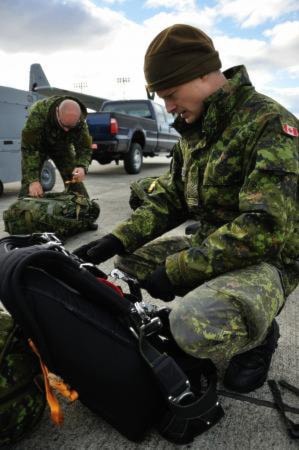“Canada and the United States share not only a border, but a great deal of commonality when it comes to operating in our Arctic region,” said Master Warrant Officer Greg Smit, a Search and Rescue Technician (SAR Tech) with Canadian Joint Operations Command.
“With the opening of the Northwest Passage and increased air travel in the North, we must collaborate to respond quickly and effectively to an incident in the Arctic.”
With this in mind, approximately 100 Canadian Armed Forces members joined their American SAR counterparts in the Alaska Air National Guard (AKANG), United States Air Force (USAF) and United States Coast Guard (USCG) to take part in the Arctic Major Air Disaster (MAJAID) Search and Rescue Exercise (SAREX) recently.
The six-day exercise served to test the collective response to a simulated airliner crash in the quickly-changing and hostile Arctic climate of North America.
Conducted within a remote training area near Fort Greely, Alaska, members of the United States Army played the role of survivors of an airliner that had crashed near the Alaska/Yukon border in bad weather.
As would happen in a real-world situation, Joint Rescue Coordination Centre (JRCC) Victoria and the Alaska Rescue Coordination Centre (RCC) worked together to launch a variety of aircraft to the scene, initially staged from Joint Base Elmendorf-Richardson, Alaska, near Anchorage.
First to arrive at the scene of the crash were Royal Canadian Air Force (RCAF) SAR Techs, USAF Para-rescuers (PJs) and Canadian Army soldiers who parachuted in and began triaging and treating the simulated casualties. Additionally, aircraft parachuted sustainment equipment and supplies, and remained at the scene, acting as airborne commanders, while circling overhead.
Maj. Matthew Harper, an HH-60 helicopter pilot with the 210th Rescue Squadron, AKANG, served as the SAR Duty Officer during the exercise.
“The RCC, located at Elmendorf, received a call from JRCC Victoria, saying there was a plane crash near the border. The duty officer then called me with a synopsis and a plan to rescue the casualties; I co-ordinated the response,” said Maj. Harper. “At that point, I tasked the crews to save lives.”
“There is a ‘tyranny of time and distance’ in Arctic SAR,” said Lieut.-Col. Carl Westerland, director of the Alaska RCC, speaking to the vast expanses that aircraft SAR crews must cover to reach a crash. “We have a challenge to keep survivors alive for 24 to 72 hours … until we can get helicopters on scene to bring people out of the field.”
Keeping a large number of people alive in an area that is far from any civilization, has little natural shelter from the harsh elements, and is home to a large number of natural predators, like bears, poses a significant difficulty.
“In Trenton (Ontario), we have four MAJAID kits that are designed to sustain up to 320 people for 48 hours,” said Capt. Angelo Manzara of the Canadian Army Advanced Warfare Centre (CAAWC), located at 8 Wing Trenton. “These requirements are based off of the average size of an aircraft flying over the Arctic these days.”
As the centre of excellence for parachuting, mountaineering and arctic operations, CAAWC holds the high-readiness MAJAID capability for the Canadian Army. “We are responsible to provide a 12-man support group; when requested, we jump in and support SAR Techs.”
With so many people and aircraft participating in the exercise, some of the most important lessons learned focused on recognizing the importance of communication and co-ordination among the various rescue personnel within the RCCs, in the air and at the crash scene itself.
— 19 Wing Comox
